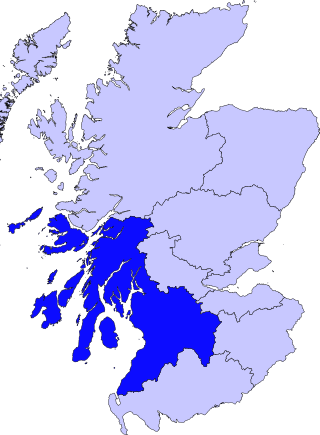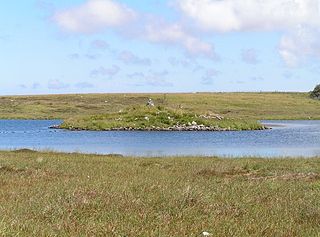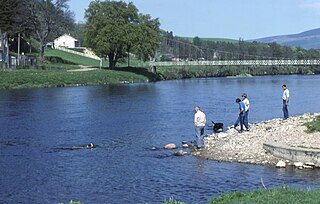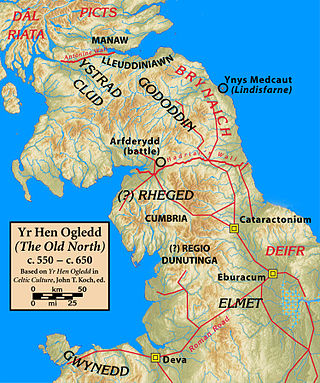
A strath is a large valley, typically a river valley that is wide and shallow (as opposed to a glen, which is typically narrower and deep). [1]

A strath is a large valley, typically a river valley that is wide and shallow (as opposed to a glen, which is typically narrower and deep). [1]
An anglicisation of the Gaelic word srath, it is one of many that have been absorbed into the English and Scots languages. It is commonly used in rural Scotland to describe a wide valley, even by non-Gaelic speakers.
In Scottish place-names, Strath- is of Gaelic and Brittonic origin. [2] Strath- names has a similar origin to Gaelic srath, meaning "broad-valley", as well as to Cumbric and Pictish cognates (cf. Welsh ystrad). [2]
Gaelic srath is derived from Old Irish srath, recorded as having meant "grassland". [3] The modern Scottish Gaelic sense of "broad-valley", paralleling the meaning of Brittonic cognates, developed from substrate influence from Pictish. [3]
It occurs in numerous place names within Scotland including Strathmore, Strathspey and Strathclyde. Abroad, many places with Scottish heritage also use the prefix, including Strath-Taieri in New Zealand; Strathalbyn in South Australia, Strathfield, a suburb of Sydney, Australia; Strathewen, Victoria, Australia; Strathpine, a suburb of Brisbane, Australia; and various places in Canada: Strathmore, Alberta; Strathcona; Strathroy, Ontario; and Strathburn, Ontario.
It also occurs in the names of five Peninsular and Oriental Steam Navigation Company liners, four of which, the Strathaird, the Strathnaver, the Stratheden and the Strathmore, carried thousands of migrants to Australia between the 1950s and the 1960s. The ships acted as troop carriers during the Second World War and the fifth ship, the Strathallan, sank in the Mediterranean in 1942 taking troops to the landings in North Africa. [4]
The word is related to Welsh Ystrad, as in Strat Clut, the Old Welsh name for the Kingdom of Strathclyde.
In Keith there is a distillery producing the Strathisla whisky. It is a single malt whisky that is also an ingredient to the blend Chivas Regal.
In geology, a strath is a bedrock surface within a river valley that marks a base level of erosion by the river. This may underlie a contemporary strath valley floor, corresponding to the present base level, but it may also correspond to a former base level now preserved in the geologic record. [5]
When a river in a strath valley is rejuvenated by a drop in base level, remnants of the former valley floor may be preserved as strath terraces. [6] These may record past climate oscillations [7] [8] or may be a result of river meandering. [9]
If a change in sedimentation rates results in renewed deposition of sediments (aggradation) in a strath valley, the original strath surface may be buried under fresh sediments and become part of the geologic record. For example, at least three such straths are present in the valley of the Rio Grande River near Albuquerque, New Mexico. [10]

The Brittoniclanguages form one of the two branches of the Insular Celtic language family; the other is Goidelic. It comprises the extant languages Breton, Cornish, and Welsh. The name Brythonic was derived by Welsh Celticist John Rhys from the Welsh word Brython, meaning Ancient Britons as opposed to an Anglo-Saxon or Gael.

A valley is an elongated low area often running between hills or mountains, which will typically contain a river or stream running from one end to the other. Most valleys are formed by erosion of the land surface by rivers or streams over a very long period. Some valleys are formed through erosion by glacial ice. These glaciers may remain present in valleys in high mountains or polar areas.

A glen is a valley, typically one that is long and bounded by gently sloped concave sides, unlike a ravine, which is deep and bounded by steep slopes. The word is Goidelic in origin: gleann in Irish and Scottish Gaelic, glion in Manx. The designation "glen" also occurs often in place names. Glens are appreciated by tourists for their tranquility and scenery.
Pictish is an extinct Brittonic Celtic language spoken by the Picts, the people of eastern and northern Scotland from Late Antiquity to the Early Middle Ages. Virtually no direct attestations of Pictish remain, short of a limited number of geographical and personal names found on monuments and early medieval records in the area controlled by the kingdoms of the Picts. Such evidence, however, shows the language to be an Insular Celtic language related to the Brittonic language then spoken in most of the rest of Britain.
Cumbric was a variety of the Common Brittonic language spoken during the Early Middle Ages in the Hen Ogledd or "Old North" in what is now the counties of Westmorland, Cumberland, northern Lancashire in Northern England and the southern Scottish Lowlands, alongside the Kingdom of Elmet in modern day Yorkshire. It was closely related to Old Welsh and the other Brittonic languages. Place name evidence suggests Cumbric may also have been spoken as far south as Pendle and the Yorkshire Dales. The prevailing view is that it became extinct in the 12th century, after the incorporation of the semi-independent Kingdom of Strathclyde into the Kingdom of Scotland.

Strathclyde was one of nine former local government regions of Scotland created in 1975 by the Local Government (Scotland) Act 1973 and abolished in 1996 by the Local Government etc. (Scotland) Act 1994. The Strathclyde region had 19 districts. The region was named after the early medieval Kingdom of Strathclyde centred on Govan, but covered a broader geographic area than its namesake.

A dun is an ancient or medieval fort. In Ireland and Britain it is mainly a kind of hillfort and also a kind of Atlantic roundhouse.

The River Spey is a river in the northeast of Scotland. At 98 mi (158 km) it is the ninth longest river in the United Kingdom, as well as the third longest and fastest-flowing river in Scotland. It is important for salmon fishing and whisky production.

Strathspey is the region around the strath of the River Spey, Scotland, split between the Moray council area and the Badenoch and Strathspey committee area of Highland.
A petty kingdom is a kingdom described as minor or "petty" by contrast to an empire or unified kingdom that either preceded or succeeded it. Alternatively, a petty kingdom would be a minor kingdom in the immediate vicinity of larger kingdoms, such as the medieval Kingdom of Mann and the Isles relative to the kingdoms of Scotland or England or the Viking kingdoms of Scandinavia.

The Britons, also known as Celtic Britons or Ancient Britons, were an indigenous Celtic people who inhabited Great Britain from at least the British Iron Age until the High Middle Ages, at which point they diverged into the Welsh, Cornish, and Bretons. They spoke Common Brittonic, the ancestor of the modern Brittonic languages.

Strathmore is a broad valley or strath in east-central Scotland, lying between the Grampian mountains and the Sidlaws. It is approximately 50 mi (80 km) long and 10 mi (16 km) wide. Strathmore is underlain by Old Red Sandstone but this is largely obscured by glacial till, sands and gravels deposited during the ice age. Its northeast to southwest alignment is influenced by the underlying geological structure of the area which reflects the dominant Caledonian trend of both the central lowlands and the Highlands of Scotland; its northern margin reflects the presence of the Highland Boundary Fault. Strathmore is fertile and has some of Scotland's best arable farmland, producing soft fruits and cereals.

Strathmore is a strath or wide valley in Sutherland in northern Scotland. The strath is in the parish of Durness to the south-east of Loch Eriboll. It runs north–south and has a minor road running alongside the Strathmore River which flows along the valley floor northwards into Loch Hope. Ben Hope is to the east.

Yr Hen Ogledd, or in English the Old North, is the historical region that was inhabited by the Brittonic people of sub-Roman Britain in the Early Middle Ages, now Northern England and the southern Scottish Lowlands, alongside the Celtic Kingdom of Elmet. Its population spoke a variety of the Brittonic language known as Cumbric which is closely related to, if not a dialect of Old Welsh. The people of Wales and the Hen Ogledd considered themselves to be one people, and both were referred to as Cymry ('fellow-countrymen') from the Brittonic word combrogi. The Hen Ogledd was distinct from the parts of North Britain inhabited by the Picts, Anglo-Saxons, and Scoti.

The languages of Scotland belong predominantly to the Germanic and Celtic language families. The main language now spoken in Scotland is English, while Scots and Scottish Gaelic are minority languages. The dialect of English spoken in Scotland is referred to as Scottish English.

Strathgryffe or Gryffe Valley is the strath of River Gryffe, which lies within the historic county of Renfrewshire in the west central Lowlands of Scotland.

The River Oykel is a major river in northern Scotland that is famous for its salmon fishing. It rises on Ben More Assynt, a few miles from Ullapool on the west coast of Scotland, and drains into the North Sea via the Kyle of Sutherland. Traditionally it has marked the boundary between Ross to the south and Sutherland to the north.
The following place names are either derived from Scottish Gaelic or have Scottish Gaelic equivalents:
Common Brittonic, also known as British, Common Brythonic, or Proto-Brittonic, was a Celtic language spoken in Britain and Brittany.

Scottish toponymy derives from the languages of Scotland. The toponymy varies in each region, reflecting the linguistic history of each part of the country.